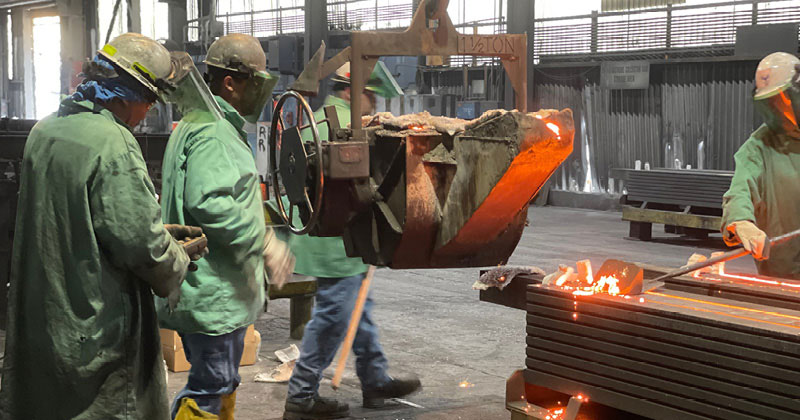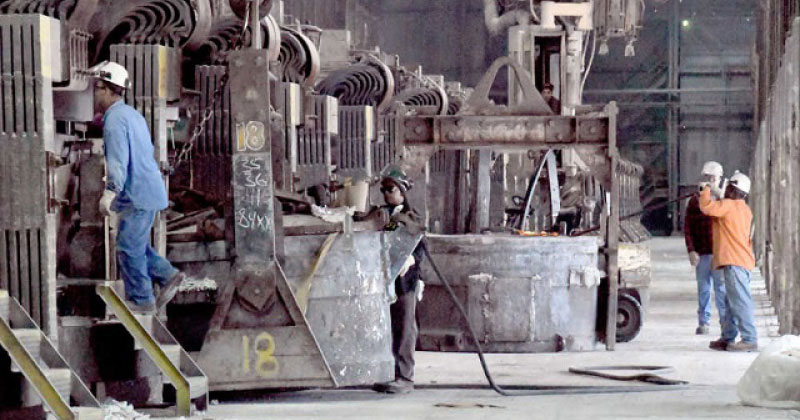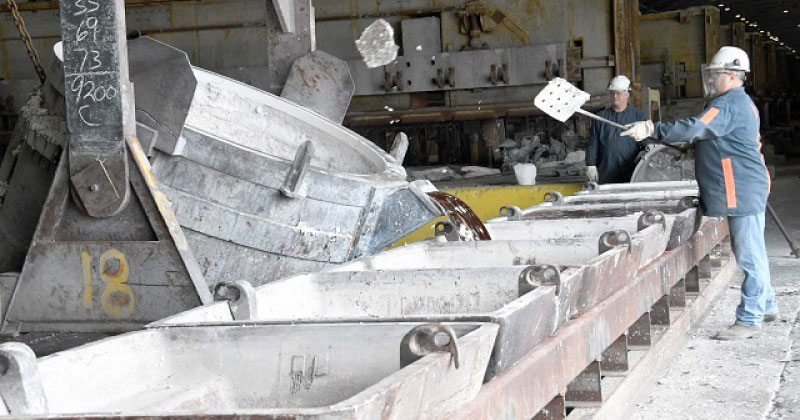
By the time Noranda Aluminum filed for bankruptcy in February of 2016, Cameron Redd and his fellow Local 7686 members at the plant had seen their share of hard times.
Over the years, pressures from unfair trade, economic downturns and high utility costs brought periodic layoffs to the smelter that once employed 1,000 workers along the Mississippi River in Marston, Mo. But the Chapter 11 filing was more than a temporary problem.
“There were a lot of bad decisions,” Redd said of the company’s actions leading up to the bankruptcy. “We could kind of see it coming as a union.”
While that awareness couldn’t prevent bankrupt Noranda from idling and selling the facility, it did give Redd and his USW siblings the experience to persevere and ultimately prevail during the next few years, as the smelter reopened and the union settled a first contract with the new owner, Magnitude 7 Metals LLC, known as Mag 7.
Good Union Jobs
When Redd landed a job at the smelter more than 15 years ago, he thought he’d reached a place where he could have a rewarding career and then retire comfortably.
“I got on, and I figured, ‘Hey, I made it,’” Redd said.
He wasn’t alone. Thanks to the strength of the USW, the jobs at the smelter were among the best in the area, good enough to draw in workers from across the “boot heel” area of southeastern Missouri as well as from neighboring states including Arkansas, Illinois, Kentucky and Tennessee.

“From my perspective, I had one of the two best jobs in this area,” Redd said, noting that a nearby electrical plant, built in large part to provide the power that is essential to aluminum production, also offered good union jobs, to members of the International Brotherhood of Electrical Workers.
Still, as a result of unfairly traded imports, high utility costs, and owners who seemed more interested in extracting profits than investing in the future of the plant, Noranda would ultimately shut down.
“At some point, I realized that I was going to have to move on,” Redd said. “I was there right up until the last week.”
Ripple Effect
The smelter’s shut down hit the region hard. In rural Missouri where the facility sits, several hundred industrial jobs can mean the difference between a thriving community and a ghost town.
The loss of Noranda’s $100 million payroll devastated local small businesses. Homes were put up for sale by the dozens, causing values to drop. Taxes that came in because of the plant had accounted for nearly 20 percent of the local school district’s budget, leaving the entire community searching for answers.
“When you take 847 good jobs out of a community like this, I don’t know how you can even measure it,” Redd said. “A lot of people who once had disposable income, suddenly they couldn’t make their car payments, couldn’t make their house payments.”
Industry Challenges
The Missouri smelter was far from the only aluminum facility to face difficult times. U.S.-based aluminum production has declined from 3.7 million metric tons from 23 smelters in 2000 to just 880,000 metric tons in 2021. Today, only five primary aluminum production sites are in operation in the United States, with two others currently idle.
Meanwhile, over the same period, China expanded its primary aluminum production from 2.8 million metric tons in 2000 to 38.8 million metric tons in 2021. China is now the world’s largest producer of the metal by a more than 10-to-1 margin over its closest competitor, Russia.
In response to that widening gap, in 2018, citing national security concerns, the United States imposed 10 percent tariffs on aluminum imports under Section 232 of the Trade Expansion Act.
Only a few smelters are capable of producing the kind of high-grade aluminum used in military vehicles, armor and aircraft, one of the reasons for the product’s designation as vital to U.S. national defense.

The Section 232 measures, which coincided with a corresponding action in support of steel producers, helped to slow the industry’s slide and paved the way for Mag 7 to restart the former Noranda facility.
USW Support
Still, preventing unfair imports is only one piece of the puzzle when it comes to the struggles aluminum producers face. Aging facilities and the large amount of electricity required in the smelting process can also be roadblocks to efficient production.
When Mag 7 took over the smelter in 2018, USW members, including International President Tom Conway, District 11 Director Emil Ramirez and other leaders, worked to ensure that the new owner could clear regulatory hurdles and other obstacles in order to restart.
“This country needs as much aluminum production capacity as we can get,” Conway said. “When we have an opportunity to restart an idled facility, this union is going to do everything we can to put our members back to work in good jobs, producing American aluminum.”
With Mag 7 determined to restart the smelter, workers were optimistic, believing they had an understanding with the company that it would recognize the union, but that didn’t happen.
Redd, who went on to become a USW staff representative, had a handful of members still working who were keeping him informed as they maintained the grounds and kept the facility viable for a possible restart.
“We just tried to keep our ears to the ground. The company was steadily sowing discord,” Redd said
Ultimately, while Mag 7 was legally obligated under Burns successorship rules to recognize the USW, the company did not do so until the USW took legal action.

Obstacles Mount
The USW filed a series of successful charges with the National Labor Relations Board, and Mag 7 ultimately agreed to meet the union at the bargaining table. Even then, however, management continued to drag its feet, eventually supporting an effort to decertify the union.
“The company just kept moving the goalposts,” Redd said.
Despite efforts to bust the union, USW members repeatedly made it clear to the company that they were committed to acting collectively. Thanks to the members’ solidarity, the union won the decertification vote decisively, and the company returned to the table ready to work toward a new collective bargaining agreement. By then, though, another major obstacle was on the horizon.
“No sooner than we got started, and we were faced with COVID,” Redd said.
Face-to-face meetings couldn’t take place for months, so bargaining stalled. And because the economy slowed down considerably as the pandemic continued, Mag 7 soon faced the possibility of having to shut down the facility yet again.
Sticking Together
Through the determination of the Mag 7 work force, members kept the plant running. And the union ultimately reached a new two-year agreement with the help of a federal mediator, a contract that now covers about 465 USW members with the plant operating at a reduced capacity.
“Putting members back to work making aluminum in southeast Missouri, and making sure they have good, community-supporting jobs, that was a tremendous victory,” Director Ramirez said. “This was an opportunity to help keep hundreds of families afloat and help put a community back on its feet.”
National Security
The Mag 7 restart also was an opportunity to push the United States closer to fulfilling its own aluminum needs, a goal that was the driving force behind the Section 232 tariffs.
While those measures managed to restore some capacity to the U.S. aluminum industry, more work must be done to ensure that American producers are competing on a level playing field, that they can meet their energy needs in a cost-effective way, and that they can support hard-working communities like those in the Marston area and elsewhere.
“China’s dumping is still happening,” Redd said. “The price of electricity is a tremendous cost in the calculation of whether a facility can be profitable. That’s always a consideration.”
The United States needs producers willing to build new smelters, and more idled facilities to return to full production, Conway said.
“We are still not as self-sufficient as we ought to be as a nation,” he said.
For now, though, the workers at Mag 7 have turned their attention to producing aluminum rather than fighting for their very survival.
“These workers were able to really do something that’s hard to do, and that is to reorganize a facility of this size after it shut down,” Redd said. “The bottom line is that the workers have a voice, and we’re making metal again here in southeast Missouri. The fight goes on.”

